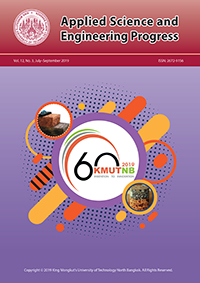Evaluation of Biodiesel Production Using Oil Feedstock from Contaminated Macro Algae in Shrimp Farming
Main Article Content
Abstract
This research was aimed to manage and utilize 3 contaminated macro algae from shrimp farming, Caulerpa lentillifera, Caulerpa racemosa and Acanthophora spicifera as an alternative oil feedstock for biodiesel production. Oil extraction was performed and biodiesel production was conducted in further to get the maximum yield. The optimization of condition, such as the molar ratio of oil to methanol, effect of reaction time, reaction temperature, and percentage of catalyst were carried out. The results were discovered that the average amount of oil from these macro algae were approximately 3.3% from dried basis. The optimum condition for biodiesel production with these 3 macro algae was nearly the same. The reaction was completed within 8 h and the achievement of biodiesel yield was 55.58% from Caulerpa lentillifera with the suitable condition of oil to methanol molar ratio 1:15 using 1% of KOH at 60°C. Caulerpa racemosa can be produced 58.36% of biodiesel from the condition of oil to methanol ratio 1:15 with 1.5% of KOH at 60°C. As well, the optimum condition for biodiesel production from Acanthophora spicifera was using 1:12 of oil to methanol ratio with 1% of KOH and obtained 49.29% of biodiesel.
Article Details
References
[2] A. B. Ross, J. M. Jones, M. L. Kubacki, and T. Bridgeman, “Classification of macroalgae as fuel and its thermochemical behaviour,” Bioresource Technology, vol. 99, pp. 6494–6504, 2008.
[3] B. Bharathiraja, M. Chakravarthy, R. R. Kumar, D. Yogendran, D. Yuvaraj, J. Jayamuthunagai, R. P. Kumar, and S. Palani, “Aquatic biomass (algae) as a future feed stock for bio-refineries: A review on cultivation, processing and products,” Renewable & Sustainable Energy Reviews, vol. 47, pp. 634–653, 2015.
[4] H. Xu, X. Miao, and Q. Wu, “High quality biodiesel production from a microalga Chlorella protothecoides by heterotrophic growth in fermenter,” Bioresource Technology, vol. 126, pp. 499–507, 2006.
[5] X. Miao and Q. Wu, “Biodiesel production from heterotrophic microalgal oil,” Bioresource Technology, vol. 97, pp. 841–846, 2006.
[6] ASTM International. (1991). Annual book of ASTM standards, Petroleum Products and Lubricants (I-III). Philadelphia, USA [Online]. Available: https://www.astm.org/BOOKSTORE/BOS/index.html
[7] K. Rohani-ghadikolaei and E. Abdulalian, “Evaluation of the proximate, fatty acid and mineral composition of representative green, brown and red seaweeds from the Persian Gulf of Iran as potential food and feed resources,” Journal of Food Science Technology, vol. 49, pp. 774–780, 2012.
[8] J. M. Encian, J. F. Gonzaliz, J. J. Rodriguez, and A. Tajedor, “Biodiesels fuels from vegetable oils; Transesterification of Cynara cardunculus L. oils with ethanol,” Energy & Fuels, vol. 16, pp. 443–450, 2002.
[9] M. P. Dorado, E. Ballesteros, J. A. Almeida, C. Schellet, H. P. Lohrlein, and R. Krause, “An alkali-catalysed transesterification process for high free fatty acid oils,” Transactions of the American Society of Agricultural Engineers, vol. 45, no. 3, pp. 525–529, 2002.
[10] R. Maceiras, M. Rodrı´guez, A. Cancela, S. Urréjola, and A. Sánchez, “Macroalgae: Raw material for biodiesel production,” Applied Energy, vol. 88, no. 10, pp. 3318–3323, 2011.
[11] E. Santillan-Jimenez, R. Pace, S. Marques, T. Morgan, C. McKelphin, J. Mobley, and M. Crocker, “Extraction, characterization, purification and catalytic upgrading of algae lipids to fuel-like hydrocarbons,” Fuel, vol. 180, pp. 668–678, 2016.
[12] C. V. Viegas, I. Hachemi, S. P. Freitas, P. Maki-Arvela, A. Aho, J. Hemming, A. Smeds, I. Heinnmaa, F. B. Fontes, D. C. da Silva Pereira, N. Kumar, G. A. G. Aranda, and D. Y. Murzin, “A route to produce renewable diesel from algae: Synthesis and characterization of biodiesel via in situ transesterification of Chlorella alga and its catalytic deoxygenation to renewable diesel,” Fuel, vol. 155, pp. 144–154, 2015.

